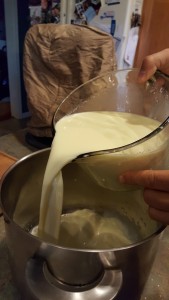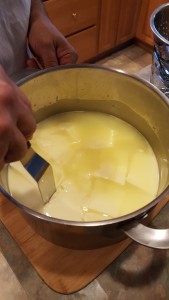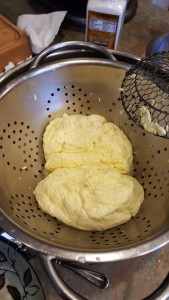I think I’m ready to share this recipe! Tony and I have tried it three times, with three different recipes and we’ve come up with what works for us. Something to note is that you should eat it the day you make it–it really doesn’t keep long!
 First of all, we made it the first two times with local (supermarket) pasteurized whole milk, but we wanted to try it with unpasteurized (or even just low temp pasteurized) to see if consistency and taste were superior. We have an Amish farm near our home (where we get our tomatoes for tomato sauce festivities), so I stopped in yesterday.
First of all, we made it the first two times with local (supermarket) pasteurized whole milk, but we wanted to try it with unpasteurized (or even just low temp pasteurized) to see if consistency and taste were superior. We have an Amish farm near our home (where we get our tomatoes for tomato sauce festivities), so I stopped in yesterday.
The farm has retail hours a few days a week and were open, so I asked one of the kids if they had milk (they had cows… so I figured it wouldn’t be a stretch they’d have it) but I had never seen it offered before. She asked if I had a container for it and I wasn’t prepared for a yes, so I said no and she immediately disappeared! She came back with a huge, heavy glass jar with the milk in it and asked me to return the jar when we were done. No problem… I took my prize and left!
Did I mention that the milk was cRaZy yellow and had thick clots of cream in it? It appeared to be separating in the jar but I didn’t want to question it (what do I know, LOL). It definitely gave a different taste to it–almost a little sour at first, however I have a hard time drinking whole milk (pasteurized and homogenized from the supermarket) because I’m so not used it it.
Bottom line: Local whole milk from the supermarket was just as good–don’t kill yourself looking for unpasteurized!
So, our recipe is a compilation of a lot of information out there around a few simple steps to make homemade cow’s milk mozzarella.
Left to right: milk into 9 quart pot; initial curds after rennet, heated to 105 F and cut for straining; curds drained and before being dropped into 180 F heated whey.
Fresh Mozzarella Cheese (~1 lb.)
Ingredients
1 Gallon Whole milk*
1.5 tsp. citric acid
¼ tablet Rennet (vegetable based)
Salt
Note about milk: *You can use any milk—just not ultra-pasturized (meaning pasteurized above 170 degrees). I’ve read that if you buy local milk it is unlikely to be ultra-pasturized–milk shipped far will likely be. From what I’ve read, if the initial curds (after rennet and waiting 10 minutes) is the consistency of ricotta cheese, then it is likely your milk might be ultra-pasteurized.
Prepare in advance:
- Dissolve 1.5 tsp. of citric acid in 3 tablespoons of cool water and set aside (if it is liquid you don’t have to do this).
- Dissolve ¼ tablet of rennet in 2 tablespoons of filtered or distilled water.
Method:
- Bring the milk to 50 degrees F in a 9 ½ quarts pot and then add the dissolved citric acid.
- Stirring every few minutes, bring the milk up to 90 degrees F over low heat (~5 minutes) and add the rennet and stir for about 30 seconds. You will see that the milk will begin to curdle and separate from the liquid (solid=curds; liquid=whey).
- Over low heat, bring the curds and whey to 105 degrees F on an instant read thermometer (~3-5 minutes). Remove from heat and let sit for 10 minutes.
- Cut the curds in squares and remove with slotted spoon to a colander, gently squeezing out extra whey and forming it into one large mass.
- You might want to cut the curd mass it in half at this point if you want to make 2 balls of cheese (~.5 lbs each), or even smaller if you want to make small balls.
- Heat half of the whey to 180 degrees F, adding 2 ½ tablespoons of salt to it, but leave the other half of the whey in a deep bowl (you will need that as well).
- Place the first curd mass (if you are doing multiples) into the hot whey for about 2 minutes until it is melted. Fish it out with the slotted spoon and then hold it by two ends and allow it to stretch on its own (if it tears instead of stretching, put it back in the hot whey). I actually do this about 3 times, gently stretching and folding once before putting it back in the hot whey.
- When you have the consistency you want, stretch it into a tight ball and place them into the room temperature whey that you set aside for about 20 minutes.
- Eat it immediately or within a few hours, you can cover with plastic and refrigerate but it doesn’t last long.
By the way, I’ve read that even low-fat milk will work although I’ve never tried. Seems to me from what I’ve read, the lower the fat, the lower the moisture of the cheese.
Are you going to try it? Let me know!




